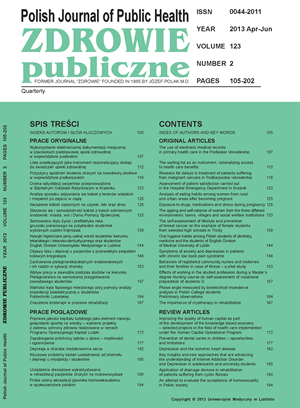The importance of cryotherapy in rehabilitation
DOI:
https://doi.org/10.12923/j.0044-2011/123-2/a.14Keywords:
cryotherapy, rehabilitation, physiotherapyAbstract
Introduction. Cryotherapy reduces the swellings, the production of irritants and pain. It is applied to treat many different diseases, as well as surgical treatments. It has become more and more common and accessible form of therapy.
Aim. The aim of the present work was to check the availability of cryotherapy in rural and urban areas.
Material and methods. The study involved 102 patients of Zamość Rehabilitation Center of University of Management and Administration, including 68 women (66.67%) and 34 men (33.33%). The research tool was an author’s questionnaire survey.
Results. Availability of cryotherapy according to 55.88% of the respondents is sufficient, whereas 44.12% of respondents believe that it is insufficient. Sufficient availability of cryotherapy was reported by 54% of respondents living in the urban area and 56% - in rural area. Most patients use the cryotherapy treatments in non-public healthcare centers (NZOZ).
Conclusions. Cryotherapy is a treatment more and more commonly available, both for those living in rural and urban areas. Doctors prescribing cryotherapy should pay special attention to contraindications and coexisting diseases
References
1. Zagrobelny Z. Krioterapia miejscowa i ogólnoustrojowa. Wrocław: Wydawnictwo Medyczne Urban & Partner; 2003.
2. Piechura R, Kaczmarek T, Załęski M. Wpływ ogólnoustrojowego oddziaływania temperatur kriogenicznych na zdolność wysiłkową. Fiz¬joterapia. 1998;6:68-72.
3. Straburzyńska-Lupa A, Straburzyński G. Fizjoterapia z elementami klinicznymi. Warszawa: PZWL; 2008.
4. Gregorowicz H, Zagrobelny Z. Krioterapia ogólnoustrojowa: wskazania i przeciwwskazania, przebieg zabiegu i jego skutki fizjologiczne i kli-niczne. Acta Bio-Opt. 1998;4:119-31.
5. Biały D, Zimmer K, Skrzek A, Zagrobelny Z. Komora kriogeniczna – możliwości krioterapii w rehabilitacji. Balneol Pol. 1998;40(3-4):44-7.
6. Mika T, Kasprzak W. Fizykoterapia. Warszawa: PWZL; 2006.
7. Rymaszewska J, Tulczyński A, Zagrobelny Z, Kiejna A. Influence of whole body cryotherapy on depressive symptoms – preliminary report. Acta Neuropsychiatrica. 2003;15:122-8.
8. Scarcella J, Cohn B. The effect of cold therapy on the postopera¬tive course of total hip and knee arthroplasty patients. Am J Orthop. 1995;24:847-52.
9. Misztela A, Kuliński W, Rybak T. Ocena krioterapii miejscowej w reu¬matoidalnym zapaleniu stawów. Balneol Pol. 1995;34(3-4):38-41.
10. Zimmermann-Górska I. Reumatologia kliniczna. Warszawa: PZWL; 2008.
11. Wilczyńska K. Przyszłość krioterapii miejscowej. Acta Bio-Optica. 2009;2:138.
12. Giemza C, Ostrowska B, Hawrylak A, et al. Wpływ krioterapii ogólnou¬strojowej na skuteczność zwalczania dolegliwości bólowych dolnego odcinka kręgosłupa. Acta Bio-Optica. 2011;17:95-8.
13. Sieroń A, Stanek A, Jagodziński J, et al. Zachowanie się wybranych par¬ametrów zapalnych u pacjentów z zesztywniającym zapaleniem stawów kręgosłupa pod wpływem krioterapii ogólnoustrojowej – wstępne do¬niesienie. Acta Bio-Opt. 2003;9(1-2):39-43.
14. Mraz M, Skrzek A, Proszkowska A, et al. Korzyści terapeutyczne w przebiegu kriorehabilitacji u chorych neurologicznych. Fizjoterapia. 2005;5(2):215-20.
15. Śliwiński Z, Łachacz K, Płaza P. Wpływ kriostymulacji miejscowej na napięcie spastyczne kończyn pacjentów po udarze mózgu. Med manual. 2000;4(1-2):55-60.
16. Miller E. Porównanie skuteczności działania krioterapii miejscowej i ogólnoustrojowej w bólu przewlekłym. Fizjoterapia Pol. 2006;6:27-31.
17. Wicha M. Krioterapia – skuteczna metoda w leczeniu i rehabilitacji urazów i schorzeń narządów ruchu. http://www.sciaga.pl/tekst/90694-91-krioterapia_skuteczna_metoda_w_leczeniu_i_rehabilitacji_urazow_i_schorzen/strona/pokaz_wszystkie (2012.07.22)
18. Geremek K, Dec L. Zmęczenie i regeneracja sił. Odnowa biologiczna. Katowice; 2007.
19. Stanek A, Cieślar G, Matyszkiewicz B, et al. Subiektywna ocena skuteczności terapeutycznej krioterapii ogólnoustrojowej u pacjentów z zesztywniającym zapaleniem stawów kręgosłupa. Balneol Pol. 2005;47(1-2):24-32.
20. Marino FE. Thermoregulation and human performance. Physiological and biological aspects. Med Sport Sci. 2008;53:89-103.
21. Łuczak J, Michalik J. Wpływ skrajnie niskich temperatur na wybrane cechy motoryczne człowieka. Fizjoterapia Pol. 2006;6:206-11.
22. Chiang LL, Wang LY, Wu CP, et al. Effects of physical training on func¬tional status in patients with prolonged mechanical ventilation, Phys Ther. 2006;86 (9):1271-81.
23. Łuczak J, Michalik J. Zmienność wybranych cech motorycznych człowieka w zależności od temperatur kriogenicznych (-130 °C i -160 °C). Balneol Pol. 2008;50(3):244-52.
24. Hagner W, Smolka A, Różańska J. Wpływ krioterapii ogólnoustrojowej na wyniki próby wysiłkowej. Balneol Pol. 2009;51(1):35-9.
25. Oosterveld F, Rasker J, Jacobs J, Overmars H. The effect of local heat and cold therapy on the intraarticular and skin surface temperature of the knee. Arth Rheum. 1992;35:146-51.
26. Levy A, Kelly B, Lintner S, Speer K. Penetration of cryotherapy in treat¬ment after shoulder arthroscopy. Arthroscopy. 1997;13:461-4.
27. Myrer J, Myrer K, Measom G, et al. Muscle temperature is affected by overlying adipose when cryotherapy is administered. J Athl Train. 2001;36:32-6.
28. Cooper C, Evidente V, Hentz J, et al. The effect of temperature on hand function In patients with tremor. J Hand Therapy. 2000;13:276-88.
29. Allison S, Abraham L. Sensitivity of qualitative and quantitative spastic¬ity measures to clinical treatment with cryotherapy. Int J Rehabil Res. 2001;24:15-24.
30. Śliwiński Z, Łachacz K, Płaza P. Wpływ kriostymulacji miejscowej na napięcie spastyczne kończyn pacjentów po udarze mózgu. Med Manual. 2000;4(1-2):55-60.
31. Miller E. Kriostymulacja czynnikiem wspomagającym rehabilitację chorych na stwardnienie rozsiane z zespołem zmęczenia. Wiad Lek. 2010;2:41-5.
32. Webb J, Williams D, Ivory, et al. The use of cold compression dress¬ing after total knee replacements: a randomized controlled trial. Orthop. 1998;21:59-61.
33. Morsi E. Continuous-flow cold therapy after total knee arthroplasty. J Arthroplsty. 2002;17:718-22.
34. Zalewski P, Klawe JJ, Pawlak J. Zmiany parametrów kurczliwości mięśnia sercowego u osób zdrowych po jednym zabiegu kriostymulacji ogólnoustrojowej. Acta Bio-Optica. 2011;4:257-61.
35. Stanek A, Cieślar G, Sieroń A. Terapeutyczne zastosowanie krioterapii w praktyce klinicznej. Balneol Pol. 2007;1:37-45.


